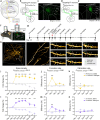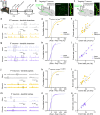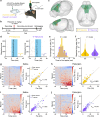This is a preprint.
Pyramidal cell types and 5-HT2A receptors are essential for psilocybin's lasting drug action
- PMID: 39554087
- PMCID: PMC11566025
- DOI: 10.1101/2024.11.02.621692
Pyramidal cell types and 5-HT2A receptors are essential for psilocybin's lasting drug action
Update in
-
Psilocybin's lasting action requires pyramidal cell types and 5-HT2A receptors.Nature. 2025 Jun;642(8067):411-420. doi: 10.1038/s41586-025-08813-6. Epub 2025 Apr 2. Nature. 2025. PMID: 40175553
Abstract
Psilocybin is a serotonergic psychedelic with therapeutic potential for treating mental illnesses1-4. At the cellular level, psychedelics induce structural neural plasticity5,6, exemplified by the drug-evoked growth and remodeling of dendritic spines in cortical pyramidal cells7-9. A key question is how these cellular modifications map onto cell type-specific circuits to produce psychedelics' behavioral actions10. Here, we use in vivo optical imaging, chemogenetic perturbation, and cell type-specific electrophysiology to investigate the impact of psilocybin on the two main types of pyramidal cells in the mouse medial frontal cortex. We find that a single dose of psilocybin increased the density of dendritic spines in both the subcortical-projecting, pyramidal tract (PT) and intratelencephalic (IT) cell types. Behaviorally, silencing the PT neurons eliminates psilocybin's ability to ameliorate stress-related phenotypes, whereas silencing IT neurons has no detectable effect. In PT neurons only, psilocybin boosts synaptic calcium transients and elevates firing rates acutely after administration. Targeted knockout of 5-HT2A receptors abolishes psilocybin's effects on stress-related behavior and structural plasticity. Collectively these results identify a pyramidal cell type and the 5-HT2A receptor in the medial frontal cortex as playing essential roles for psilocybin's long-term drug action.
Keywords: Psychedelic; dendritic spines; depression; frontal cortex; serotonin; structural plasticity.
Conflict of interest statement
Competing interests A.C.K. has been a scientific advisor or consultant for Boehringer Ingelheim, Empyrean Neuroscience, Freedom Biosciences, and Psylo. A.C.K. has received research support from Intra-Cellular Therapies. The other authors report no financial relationships with commercial interests.
Figures






References
Additional References
Publication types
Grants and funding
LinkOut - more resources
Full Text Sources
